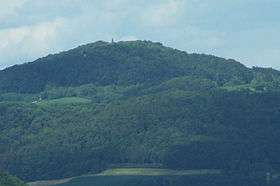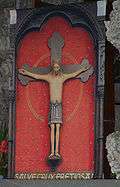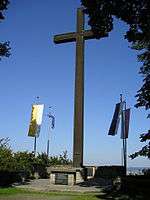Hülfensberg
| Hülfensberg | |
|---|---|
| Stuffenberg | |
 Hülfensberg, view from east, 2009 | |
| Highest point | |
| Elevation | 448 m (1,470 ft) |
| Coordinates | 51°13′8″N 10°9′29″E / 51.21889°N 10.15806°ECoordinates: 51°13′8″N 10°9′29″E / 51.21889°N 10.15806°E |
| Geography | |
| Geology | |
| Age of rock | Triassic |
The Hülfensberg (called Stuffenberg in the Middle Ages) is a 448 m high, heavily wooded mountain in the Geismar municipality in the Eichsfeld district, Thuringia, Germany. The mountain has been a pilgrimage site since the late Middle Ages, and on its summit are a church containing a 12th-century crucifix, a Franciscan monastery, a chapel dedicated to Saint Boniface, and a large free-standing cross.
The medieval name for the mountain was Stuffenberg, from which the supposed Germanic god Stuffo derives his name.[1] According to some sources the name was changed in the 14th century (or around 1400) because of a famous crucifix in the church, the Hülfenskreuz;[2][3] another etymology for the modern name was given in 1575, based on the legend that Boniface had defeated an army of unbelievers on the mountain, which was subsequently named Hülfensberg (helfen: to help) in reference to divine help.[4]
Pilgrimage
The Hülfensberg has been a pilgrimage site since the late Middle Ages, and at one point was one of the seven most popular such sites in Germany; the goal of these pilgrimages was a 12th-century crucifix.[5] Today pilgrimages occur throughout the year.[6] During the East-West division of Germany, the Hülfensberg was less than a kilometer from the border, on the eastern side, meaning that opportunities for pilgrimage were restricted to a small number of people. According to Father Heribert (one of the Franciscan monks, 2010), attendance dropped by two-thirds in 1953, the year after the Hülfensberg was placed inside the expanded and protected border area. Permission for visits to the mountain was usually only granted to locals; all others interested in pilgrimage had to request permission, and half were denied.[7] As of 2010, some 250 pilgrims attend Sunday mass in the church,[7] and 1000 to 2000 people participate in each of the four major pilgrimages per year.[8]
Hülfenskreuz

The focal point of pilgrimage on the Hülfensberg is the Hülfenskreuz, a 12th-century Romanesque crucifix.[5] It is one of the most popular pieces of sacral art in the Erfurt diocese[9] as well as one of the most important.[10]
The wooden sculpture is of Christ as a king[9] looking straight ahead (in a "strong frontality"), wearing a crown. A renovation in 1850 reconnected the legs with the cross.[11] While the 12th-century origin of the cross is oft-repeated, Georg Dehio's Handbuch der deutschen kunstdenkmäler states that it may well be a later imitation.
The crucifix is placed on a red background covered with gold stars.[12] The frame bears a motto in Latin, Salve Crux Pretiosa (Hail, precious cross).[7] According to the local Franciscans, occasionally miracles happen on the site.[12]
St. Salvator church
On top of the Hülfensberg is the St. Salvator church, which was built circa 1360–1367 as a sanctuary,[5] on the remains of an older church (on the south side of the current church, next to the sacristy), dated circa 1000.[6]
The oldest document pertaining to the Hülfensberg is a papal deed from 1351,[13] which names the parish St. Salvator auf dem Stuffenberg.[6] A later deed naming the location is dated 30 May 1352; at this time the Hülfensberg belonged to the St. Martin monastery in Heilbad Heiligenstadt, which in turn handed over the patronage to the Cistercian monastery of Anrode in 1357.[6] Pilgrimages to the Hülfenskreuz, found at the church's Gnadenaltar, started from Anrode.[6]
In 1583 the area and its church were transferred to the Archbishopric of Mainz, and remained Catholic during the Protestant Reformation. In the course of time, the St. Salvator church was expanded and renovated a number of times, most notably during the Baroque era. In 1810, the Anrode monastery was dissolved by Jérôme Bonaparte and sold, with all its possessions, to Franz Just Wedemeyer, of the Wedemeyer family, making the Hülfensberg private property. Eleven years later, Wedemeyer gave the top of the mountain, with its church, to the bishop. In 1890, the church was again expanded, in a neo-Gothic style, by Franciscan architect Paschalis Gratze.[6] The original Boniface chapel, adjacent to the church, was torn down and rebuilt on a different location; the foundation of the old chapel was the base for the new apse, with altar and choir. In 1984, while the church was located in East-Germany, the roof on a church tower was renovated with materials paid for in West-German money through Genex, the East-German commercial exchange.[14]
Boniface chapel
Next to the church is a chapel dedicated to Saint Boniface, built in 1903 on the foundations of an earlier chapel.[6] According to local legend, this is where Boniface cut down a Donar Oak, a sacred, pagan tree, in the early 8th century. This legend is based on the proximity of the village Geismar, a place mentioned in the Boniface vitae[15]—but, scholars agree now, this is in reference to another Geismar, now a part of Fritzlar in northern Hesse.[16]
Another legend says that Boniface stood on the top of the Hülfensberg and said, Wann wird endlich Frieden schweben über dieser schönen Aue ("when will peace at last hover over this lovely forest?"). Folk etymology derived from his supposed words the local place names Wanfried, Frieda (in Meinhard), Schwebda (likewise in Meinhard), and Aue (in Wanfried).
Franciscan monastery
Franciscans founded a monastery (the oldest in the Eichsfeld area), also named Hülfensberg, on top of the mountain;[6] on 16 April 1860, two priests and two lay brothers dedicated the monastery—originally, these were to found a new sanctuary at Klüschen Hagis, with the Hülfensberg being nothing but a provisional church.[7]
During the Kulturkampf, the monastery was forced to close for twelve years. When in May 1952 the East-German government strengthened the nearby border and its Sperrzone (which placed the Hülfensberg inside the protected zone), the monastery and the church suffered a steep drop in attendance.[7]
As of 2011, four Franciscans live in the monastery, which belongs to the German Franciscan province of St. Elisabeth, whose seat is in Munich.[17]
Dr. Konrad Martin Kreuz

Konrad Martin, Bishop of Paderborn from 1856 to 1875, was born in nearby Geismar. In his honor, a steel cross was erected on top of the Hülfensberg[7] and dedicated on 7 August 1933.[18] The cross is 18.60 m (61.0 ft) tall.[10] It was taken down in 1990, restored and put back up in May 1991.[2] In March 1990, after the Unification of Germany, a plaque was dedicated at the foot of the cross to remember the "victims of the fascist and stalinist dictatorship".[2]
References
- Notes
- ↑ Wolf; qtd. in Löffler 7.
- 1 2 3 Koether, Ulrich. "Der Hülfensberg". Heilbad Heiligenstadt im Eichsfeld. Retrieved 5 November 2011.
- ↑ Weigel et al 14.
- ↑ Gropper 293; transl. in Löfler 4–5.
- 1 2 3 Ullrich 129.
- 1 2 3 4 5 6 7 8 "Geschichte des Hülfensberges". Förderkreis Hülfensberg. 2007. Retrieved 5 November 2011.
- 1 2 3 4 5 6 Jauch, Karsten (17 April 2010). "Berg der heiligen Hülfe". Ostthüringer Zeitung. Retrieved 5 November 2011.
- ↑ Schenck, Susanne von (13 June 2009). "'Über allem Elend schwebt der katholische Himmel': Ein Besuch im katholischen Eichsfeld". dradio.de. Deutschlandradio Kultur. Retrieved 5 November 2011.
- 1 2 Keppler 9.
- 1 2 Sucher and Wulitzer 67.
- ↑ Handbuch 627.
- 1 2 Schenck, Susanne von (17 September 2011). "Von Protestanten umringt Das Eichsfeld, katholische Enklave in Thüringen". dradio.de. Deutschlandradio Kultur. Retrieved 5 November 2011.
- ↑ "Zeugnisse der Verehrung des hl. Bonifatius im Eichsfeld und im Werratal: Fotoausstellung". Förderkreis Hülfensberg. 2007. Retrieved 5 November 2011.
- ↑ Rang, Ute (9 September 2011). "Auf dem Kolonnenweg (31): Bruder Maximilian lebt auf dem Hülfensberg". Thüringer Allgemeine. Retrieved 5 November 2011.
- ↑ Willibald; trans. in Talbot 45–46
- ↑ Lutz 41–42.
- ↑ "Gemeinschaft der Franziskaner". Förderkreis Hülfensberg. 2007. Retrieved 5 November 2011.
- ↑ "Literatur". Förderkreis Hülfensberg. 2007. Retrieved 5 November 2011.
- Bibliography
- Dehio, Georg (1914–2007). Handbuch der deutschen kunstdenkmäler. Echo. ISBN 978-1-4068-1576-4.
- Gropper, Kaspar (1898). Die nuntiatur-korrespondenz Kaspar Groppers: nebst verwandten akfenstücken (1573–1576). F. Schöningh.
- Keppler, Josef (2000). Unser schönes Eichsfeld. Duderstadt: Mecke. ISBN 978-3-932752-59-9.
- Kohl, Albert (2009), Der Hülfensberg und sein Nahbereich vor, während und nach dem Fall der innerdeutschen Grenze 1989 (DVD), Duderstadt: Förderkreis Hülfensberg; Mecke, ISBN 978-3-86944-009-5
- Löffler, Klaus (1925). Der Hülfensberg im Eichsfelde: eine Bonifatiusstätte? (2 ed.). Duderstadt: Mecke.
- Padberg, Lutz von (2003). Bonifatius: Missionar und Reformer. C.H. Beck. ISBN 978-3-406-48019-5.
- Müller, Thomas T. (2003). Ein Zeichen aus Stahl und Licht: das Konrad-Martin-Kreuz auf dem Hülfensberg. Duderstadt: Förderkreis Hülfensberg; Mecke. ISBN 978-3-936617-12-2.
- Röhrig, Hermann (1926). Der Hülfensberg, die Stätte großer geschichtlicher Vergangenheit und landschaftlicher Schönheit. Duderstadt: Mecke.
- Schüttel, Hermann (2009). Der Hülfensberg im Eichsfeld: Begegnungsstätte in Deutschlands Mitte. Heiligenstadt: Cordier. ISBN 978-3-939848-17-2.
- Sucher, Kerstin; Wulitzer, Bernd (2006). Thüringen: Wartburg, Erfurt, Thuringer Wald. DuMont. ISBN 978-3-7701-6396-0.
- Talbot, C.H. (1954). The Anglo-Saxon Missionaries in Germany: Being the Lives of S.S. Willibrord, Boniface, Sturm, Leoba and Lebuin, together with the Hodoeporicon of St. Willibald and a Selection from the Correspondence of St. Boniface'. Sheed and Ward.
- Ullrich, Maren (2006). Geteilte Ansichten: Erinnerungslandschaft deutsch-deutsche Grenze. 9783351026394.
- Weigel, Heinrich; et al. (1999). Tannhäuser in der Kunst. Quartus. ISBN 978-3-931505-33-2.
- Willibald (1905). "Vita Bonifatii Auctore Willibaldo". In Wilhelm Levison. Vitae Sancti Bonifati Archiepiscopi Moguntini. Hahn. pp. 1–58.
- Wolf, Johann Vinzenz (1802). Stuffo kein thüringisher Abgott. Nova Acta Academiae Electoralis Moguntinae Scientiarum utilium quae Erfurti est. 11. Erfurt: Beyer u. Maring.
External links
| Wikimedia Commons has media related to Hülfensberg. |
- Huelfensberg.de – Website of the Franciscan Hülfensberg monastery
